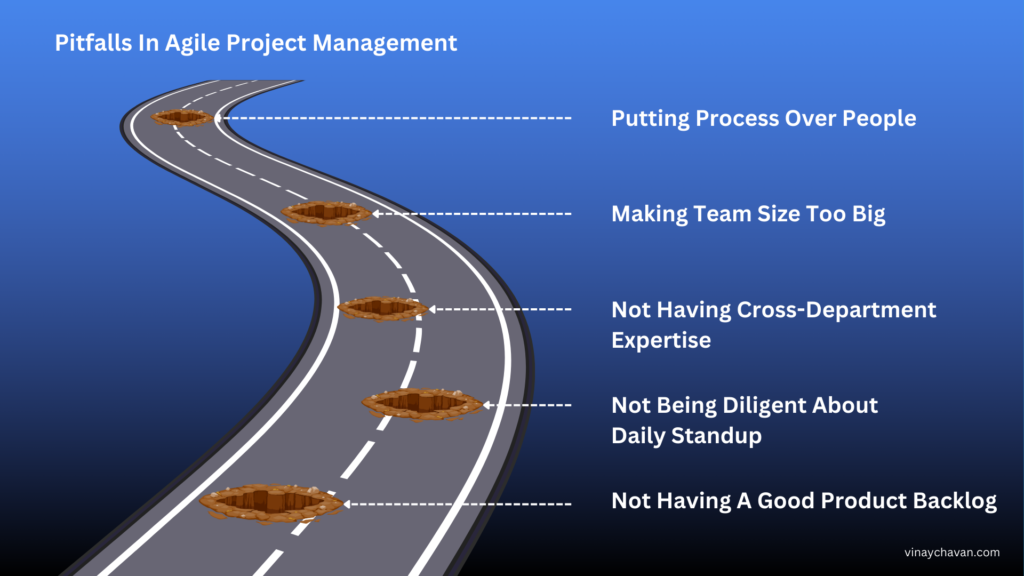In the dynamic world of project management, embracing agile methodologies like Scrum has become increasingly popular. Scrum, with its focus on collaboration, adaptability, and iterative development, offers a robust framework for achieving project success. However, despite its effectiveness, many project managers make common mistakes in Scrum team implementations that can hinder progress and diminish the framework’s potential.
In this article, we will explore five prevalent mistakes made by project managers when implementing Scrum. Each of these missteps, from prioritizing process over people to neglecting the importance of a well-maintained project backlog, can significantly impact a project’s outcome. By understanding these pitfalls and how to avoid them, project managers can enhance their Scrum practices and lead their teams to greater success.

Pitfall 1 – Putting Process Over People
Scrum is often viewed as a set of rules and ceremonies that must be strictly followed. While adherence to the Scrum framework is crucial, it should never come at the expense of the people involved. One common mistake project managers make is placing too much emphasis on process and too little on the individuals who make up the Scrum team.
Scrum is inherently people-centric, promoting collaboration, self-organization, and continuous improvement. Every process is a waste by definition, and Scrum aims to keep waste to a minimum by focusing on what adds value. When project managers become overly rigid in their approach, team members may feel stifled and disengaged. It’s essential to remember that Scrum is a guide, not a rulebook, and it should be adapted to fit the unique needs and dynamics of the team.
To avoid this mistake, project managers should encourage open communication, active participation, and a culture of trust within the team. Everyone in the Scrum team is considered a leader, and there are no designations like team lead. By prioritizing the people over the process and embracing the idea that everyone is a leader, project managers can create a more motivated and productive Scrum team.
Pitfall 2 – Making Team Size Too Big
Scrum advocates for small, cross-functional teams that can work collaboratively to deliver value quickly. However, some project managers make the error of assembling teams that are too large. Large teams can lead to communication challenges, increased complexity, and difficulties in reaching consensus.
The ideal Scrum team size typically ranges from five to nine members, allowing for efficient collaboration and effective decision-making. Larger teams may struggle to coordinate efforts, resulting in delays and reduced productivity. To address this mistake, project managers should carefully consider the skills and expertise needed for the project and aim to keep teams within the recommended size range. Smaller teams tend to be more agile and adaptable, which aligns with the core principles of Scrum.
Pitfall 3 – Not Having Cross-Department Expertise
Scrum teams are expected to be self-sufficient and possess the necessary expertise to complete a project independently. However, some project managers make the mistake of creating teams with a limited skill set, leading to dependencies on other departments or specialists.
This can result in bottlenecks and delays as teams wait for external support or information. To avoid this pitfall, project managers should strive to assemble cross-functional teams with diverse skills and expertise. When team members come from different backgrounds and possess a range of skills, they can tackle challenges more effectively and make informed decisions without relying on external resources.
Encouraging cross-training and knowledge sharing among team members can also help build a more versatile and self-reliant Scrum team, aligning with the agile principles of adaptability and flexibility.
Pitfall 4 – Not Being Diligent About Daily Standup
The daily standup, or daily Scrum meeting, is a vital component of the Scrum framework. It serves as a brief, daily check-in where team members discuss progress, challenges, and plans. Every day standup is like a heartbeat of the team, keeping it synchronized and informed.
When the daily standup is not given proper attention, it can hinder progress tracking, issue identification, and timely problem-solving. To avoid this mistake, project managers should ensure that daily standups are held consistently and follow a structured agenda. During these meetings, team members should share updates, impediments, and their plans for the day.
Creating a culture of transparency and open communication during daily standups can enhance collaboration and keep the team aligned with the project’s goals. Project managers should actively participate in these meetings, facilitating discussions and removing obstacles to keep the team’s progress on track.
Pitfall 5 – Not Having a Good Project Backlog
A well-maintained and prioritized project backlog is the foundation of effective Scrum planning and execution. Unfortunately, some project managers make the mistake of not dedicating enough time and effort to keep the backlog refined and up-to-date.
Without a clear and well-prioritized backlog, teams can lose focus, and it becomes challenging to determine what to work on next. To avoid this mistake, project managers should regularly conduct backlog grooming sessions. During these sessions, the team reviews and prioritizes backlog items, ensuring that they align with the project’s goals and objectives.
Maintaining a good project backlog not only helps the team stay organized but also enables them to deliver value consistently and respond to changing priorities effectively.
In conclusion, Scrum is a powerful framework for agile project management, but its success depends on how well it is implemented. Project managers must be mindful of these common mistakes and take proactive steps to address them. By prioritizing people over process, optimizing team size, fostering cross-departmental expertise, conducting effective daily standups (the heartbeat of the team), and maintaining a well-organized project backlog, project managers can set their Scrum teams up for success and deliver outstanding results. In Scrum, everyone is a leader, and there are no single leaders or team leads, emphasizing the importance of collaboration and shared responsibility.
